
Writing historical fiction is time consuming to say the least. Each scene that surrounds a character must be true for the reader, and the easiest way to make this scene true, is research and more research. You cannot afford to be wrong, unless of course you do it deliberately, because you are writing an ‘alternate history’ novel.

A few years ago I wrote an historical novel, which took me at least two years to research. I’d write a scene and then study it to make sure that a character could do what I wanted. For example, I had the main character board a coach in London to travel to Liverpool in 1804. The first thing that comes to mind, was from where in London would he leave – research.

How big was the coach, how many horses, how many passengers, did they all sit inside or did some sit on top and if so was it cheaper to travel ‘up top’ than inside? Research, research and more research.
My wife considers that I am more interested in the research side of writing than I am in producing the finished novel. There may be some truth in her comment . . .
Small details can pop up that you consider and then either use or discard. Too many details will slow the story and you are trying to entertain, not educate, but you do inadvertently educate, so accuracy matters.
One small detail that I didn’t use was that the cost for sitting inside was 5d (five pence) per mile and if you sat up top it was 2 1/2d (twopence h’penny). If I play trivia pursuit on NYE I wonder if I’ll get this question?
How fast did the coach travel, – the average speed being about eight to ten miles an hour until the roads were improved by Mr. McAdam allowing the speed average to increase to fourteen miles an hour.

How long was it before the horses were changed?
The route was cut in to ‘stages ‘ hence the coach was a ‘stagecoach’- and they would change the horses every ten to fifteen miles.
Some stage stops would allow the passengers to have a meal, but if a coach carried mail many stage stops would be to just change horses, and the post office would only allow five minutes for this procedure, but a crack team could do it in three minutes. To warn the inn and to save time the guard at the rear of the coach would sound his horn in a way to warn the coaching inn that they were approaching, and to have the horses ready for the change. The tone of the sound informed the inn keeper that the coach only wanted fresh horses or that it was a meal stop.
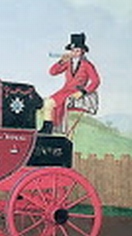
Was there anything special about the coach; – a Royal Mail coach would have the origin city’s name and the destination city’s name blazoned on the side along with the Royal coat of arms. Royal Mail coaches used numbers whereas commercial coaches gave their service names ‘The Flyer’, ‘The Union’, ‘The Courier, and ’Umpire’ was a Liverpool bound coach and so on.
One would think that a novelist could make up the answers to many of the questions, but if he was wrong then this would taint the overall story and if a reader thought that the author had ‘cheated’ then the reader might not finish the book or the they might post a negative review, which would be worse.
In my novel I had the London to Liverpool coach stop at an inn at Stony Stratford, which was well known as a stopping place for stagecoaches on their way north to Liverpool, Manchester etc, Stony Straford being a day’s ride from London.
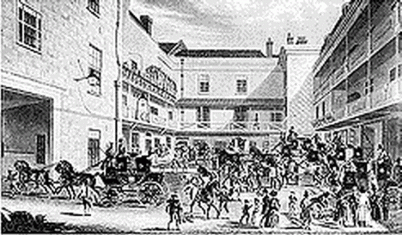
The picture illustrates the inside of a coaching inn (not Cock Inn).
The inn I used was the Cock Inn, which is just up the road from the Bull Inn, which was also a coaching inn. It is known the both inns would exaggerate their services and after a time a story teller would be told that his story was a load of Cock and Bull.
Jon Cok was the original landlord in 1480, which is how the inn got its name not from the bird. Although the pub sign shows the bird.

Stony Stratford has been around since 1194, and the word ‘Stratford’ in Anglo-Saxon means a ford on a Roman road – the ford being across the River Ouse. The ‘stony’ bit is referring to the stones on the bed of the river.
A friend of mine from my Conway days, who lives near Stony Stratford and had read my book, sent me photographs of the same street today.

The Cock Inn is now a hotel.

As is the Bull Inn, which is to the right of the Cock Inn.

The Bull Inn can be seen on the right of the picture with its Bull Inn sign and further along the road, near the flower baskets close to the lady in red, is the Cock Inn.

Cock Inn late 1800’s – I doubt that this coach & four was on its way to Liverpool.
All this research for a small part of one chapter – if nothing else I learned a lot.
If you wish to know the connection between the slave picture and my book, read the blurb on the book’s cover. If it is unclear or too small, try this link




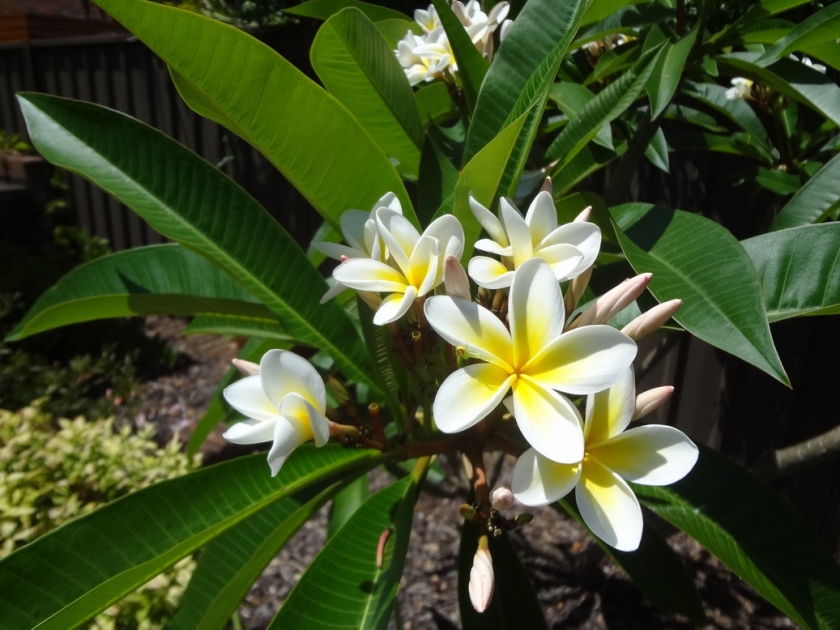 Frangipanis with their distinct perfume is on one of my favourite flowers. We have both yellow and red flowering frangipanis.
Frangipanis with their distinct perfume is on one of my favourite flowers. We have both yellow and red flowering frangipanis.
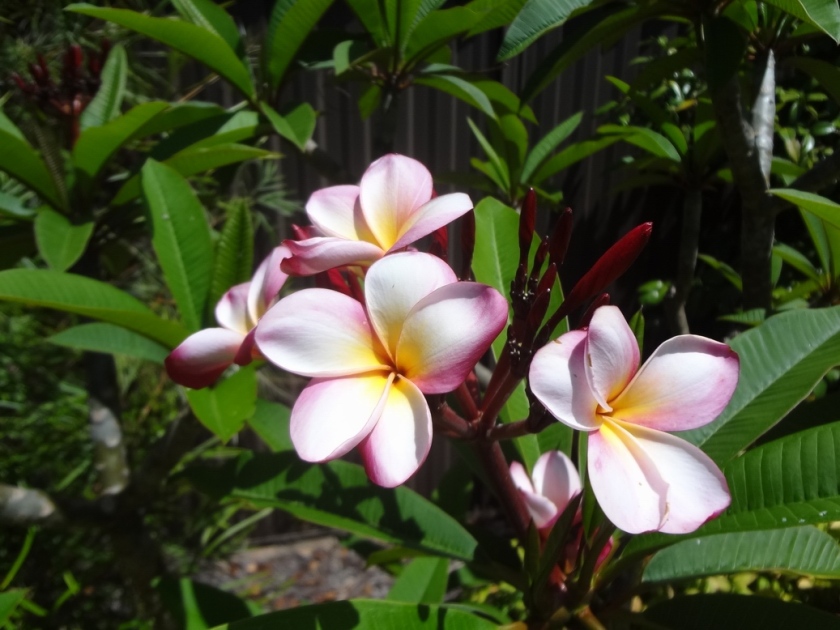

 We used to have several different varieties of chillies, from very hot to a more civilised ‘hot’, but now we just have the one kind (Birds Eye I think they are called, which has nothing to do with the frozen food company). They seed themselves – one less job . . . If the crop is too large we just freeze them whole and they last for years. Chillies are easy to grow in our climate, as are most herbs.
We used to have several different varieties of chillies, from very hot to a more civilised ‘hot’, but now we just have the one kind (Birds Eye I think they are called, which has nothing to do with the frozen food company). They seed themselves – one less job . . . If the crop is too large we just freeze them whole and they last for years. Chillies are easy to grow in our climate, as are most herbs.

 I used to pick the stink buds of by hand and drop them in to kero – but I always used gloves because they give off a liquid (defense mechanism) that STINKS and the liquid dyes the hand orange / yellow and it will not come off, regardless of the amount of scrubbing and the use of soap or white spirit. It does eventually come off after a few days only because one grows new skin.
I used to pick the stink buds of by hand and drop them in to kero – but I always used gloves because they give off a liquid (defense mechanism) that STINKS and the liquid dyes the hand orange / yellow and it will not come off, regardless of the amount of scrubbing and the use of soap or white spirit. It does eventually come off after a few days only because one grows new skin.


 Picture from the Maritime Museum web site.
Picture from the Maritime Museum web site. Dennis Adams painting (1983) illustrates AE1 at sea.
Dennis Adams painting (1983) illustrates AE1 at sea.







 As you see Madagascar was too close to Kenya and Tanzania (then it was called Tanganyika), which were both under British control. Plus, it was a short sail from Durban in South Africa. Mozambique was Portuguese territory, and they were neutral during the war.
As you see Madagascar was too close to Kenya and Tanzania (then it was called Tanganyika), which were both under British control. Plus, it was a short sail from Durban in South Africa. Mozambique was Portuguese territory, and they were neutral during the war. HMS Karanja was part of the Eastern landings.
HMS Karanja was part of the Eastern landings. After Karanja had landed her troops at Bougie she moved back out to sea, when on the morning of the 12th November at 05.30 am she was attacked by German Ju88 bombers.
After Karanja had landed her troops at Bougie she moved back out to sea, when on the morning of the 12th November at 05.30 am she was attacked by German Ju88 bombers.

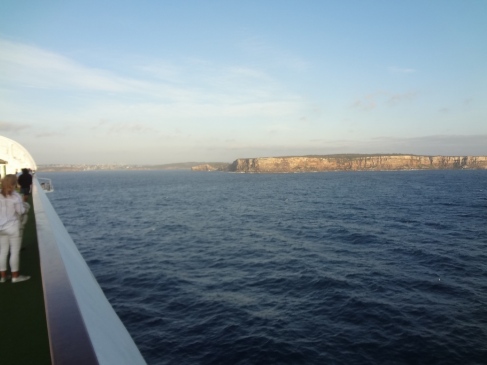
 South of the Heads
South of the Heads Still south of the Heads but with the zoom I managed to capture the ‘coat hanger’ in the distance.
Still south of the Heads but with the zoom I managed to capture the ‘coat hanger’ in the distance. Entering the Heads
Entering the Heads


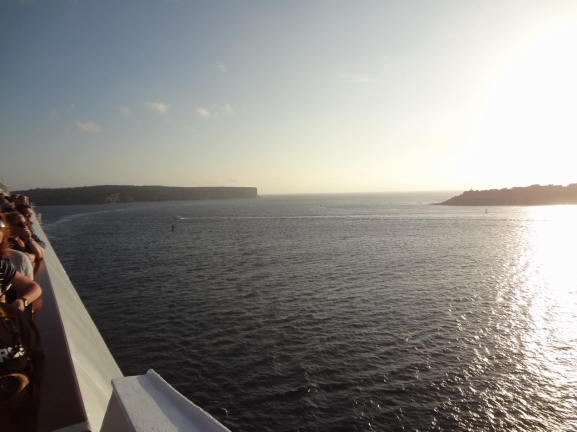






 As soon as we stepped ashore the small market came to life.
As soon as we stepped ashore the small market came to life.


 This is the best picture that I could find.
This is the best picture that I could find.
 I stood with my back to the memorial and took this photo – the place felt peaceful.
I stood with my back to the memorial and took this photo – the place felt peaceful.
 As we sailed from Maré a lonely yacht entered the harbour.
As we sailed from Maré a lonely yacht entered the harbour. A slight explanation – note the hat that I acquired in Robe, which is a small coastal town in South Australia, a couple of years ago during our road trip.
A slight explanation – note the hat that I acquired in Robe, which is a small coastal town in South Australia, a couple of years ago during our road trip. Isla and Olivia (grand daughters) joined in the Gatsby period – the head gear was made in the Kid’s Club, along with long dangling necklaces.
Isla and Olivia (grand daughters) joined in the Gatsby period – the head gear was made in the Kid’s Club, along with long dangling necklaces. Josh (grandson) wanted my hat.
Josh (grandson) wanted my hat. After the evening meal I tried to play
After the evening meal I tried to play  The Gatsby Gang
The Gatsby Gang Matt (son-in-law) with three great Gatsby kids.
Matt (son-in-law) with three great Gatsby kids. One more sunset, which in the picture is setting over Australia, and we will see the ‘Heads’ of Sydney harbour, the following morning, which will be the end of our cruise.
One more sunset, which in the picture is setting over Australia, and we will see the ‘Heads’ of Sydney harbour, the following morning, which will be the end of our cruise.


 – very more-ish if you were staying the night. . . . .
– very more-ish if you were staying the night. . . . .


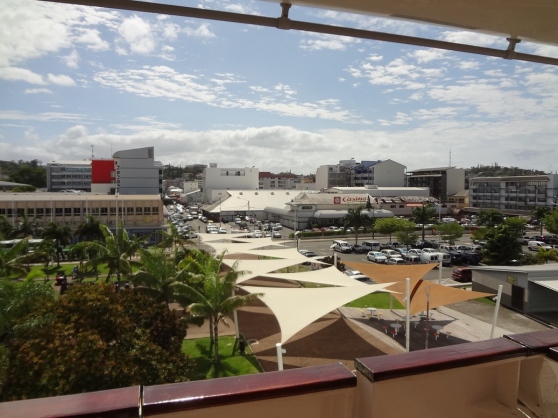


 This craft could carry about 140 people.
This craft could carry about 140 people.

 As Pacific Jewel swung on her anchor she appeared to be quite close at times. The motto on the stern is ‘Like no Place on Earth’. The swimmers in the water were from the ship.
As Pacific Jewel swung on her anchor she appeared to be quite close at times. The motto on the stern is ‘Like no Place on Earth’. The swimmers in the water were from the ship. – the black pier is where our boats tied up to take on or drop off passengers.
– the black pier is where our boats tied up to take on or drop off passengers. You know who, cast a drift on a desert island.
You know who, cast a drift on a desert island.
 Grand-daughters joined in the fun.
Grand-daughters joined in the fun. The ship’s children’s dance team helped to get the children in to the swing of things.
The ship’s children’s dance team helped to get the children in to the swing of things. Some of us just watched . . . Maureen & Sara (our daughter)
Some of us just watched . . . Maureen & Sara (our daughter)
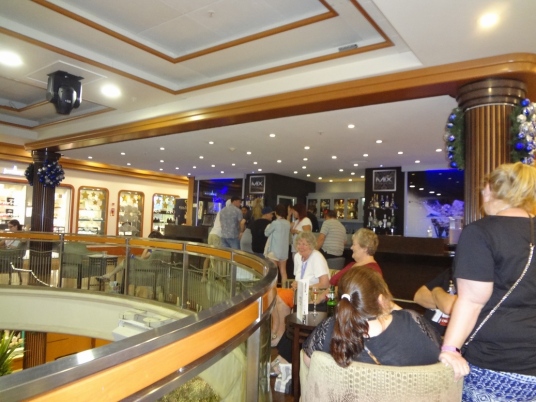 We often sat on the top floor of the atrium, because it had a small bar called Mixes, and we were as far as possible away from any loud music.
We often sat on the top floor of the atrium, because it had a small bar called Mixes, and we were as far as possible away from any loud music.








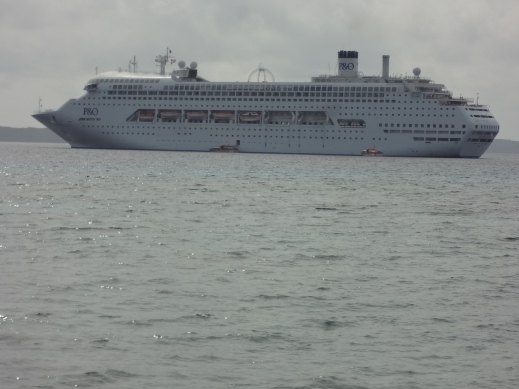


 .
.





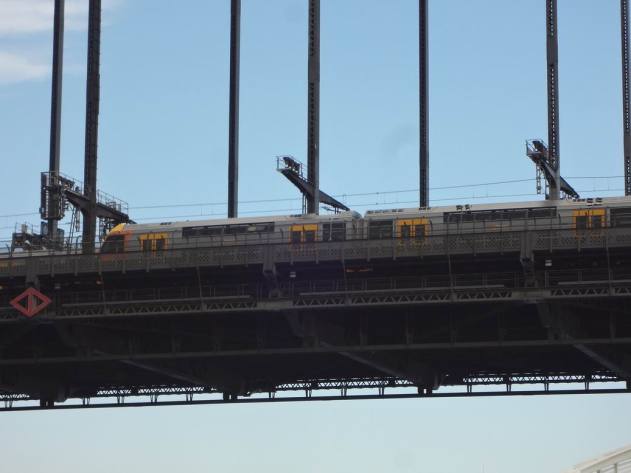 Train passing overhead.
Train passing overhead.


 Walkers on top of the bridge waving like mad as we pass under them . . .$288 plus / person for a daylight climb, $353 to $383 for a twilight climb to watch the sunset, $248 to $273 for a night time climb, and $373 to $383 for a dawn climb. I moved to Sydney in 1985 from Melbourne and as yet I have not ‘done’ the climb. There are a few hundred reasons why I haven’t, all of them include the $ sign.
Walkers on top of the bridge waving like mad as we pass under them . . .$288 plus / person for a daylight climb, $353 to $383 for a twilight climb to watch the sunset, $248 to $273 for a night time climb, and $373 to $383 for a dawn climb. I moved to Sydney in 1985 from Melbourne and as yet I have not ‘done’ the climb. There are a few hundred reasons why I haven’t, all of them include the $ sign.


 Approaching the harbour entrance and leaving the city behind.
Approaching the harbour entrance and leaving the city behind. It wasn’t long before both granddaughters were in the pool.
It wasn’t long before both granddaughters were in the pool.

 As he zooms passed.
As he zooms passed.
